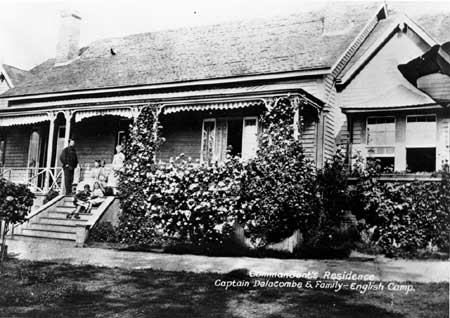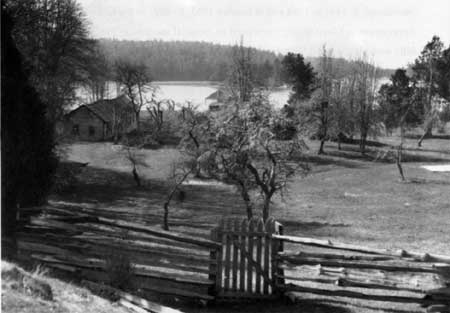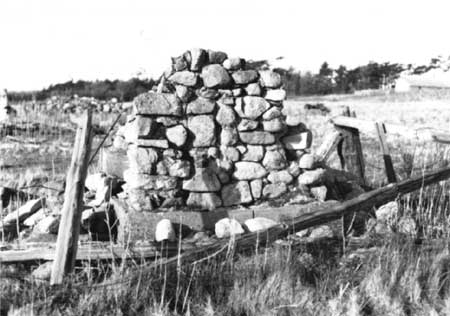|
San Juan Island
Administrative History |

|
CHAPTER 3:
Preserving American and English Camps
The first public recognition of the two military camps came on October 21, 1904, when the University of Washington State Historical Society held ceremonies to dedicate two stone monuments, one at each camp, in recognition of the peaceful settlement of the boundary dispute. At English Camp, a monument was placed on the hillside next to the remains of the Captain's Quarters. At American Camp, a monument was placed at the Redoubt. Among those in attendance were the president of the University of Washington, E. D. Warbass, John McMillin, retired General George Dandy, and Commander V. L. Cottman of the U.S.S. Wyoming, which anchored in Griffin Bay. The Puget Sound Artillery Band of Port Townsend provided music for the ceremonies. [1]
The two camps never faded from public memory as the sites of military occupation. From the moment the two contingents vacated the island the sites were known as American and English camps. Buildings at the camps were utilized for homes or other uses. In the spring of 1894, the captain's residence at English Camp was purchased and used as a summer residence by a Mr. Rogers of New York. Unfortunately, the home burned to the ground that October. [2] On June 22, 1921, Chester Kitsop and Francis Mullen were married in ceremonies held on the Redoubt. At English Camp, where Englishman William Crook had filed a homestead claim, his family would live in the Barracks building twice, once after their own house burned down. From the turn of the century forward, people stopped at English Camp where Jim Crook, who was two when his father settled at the site, would provide a tour of the grounds. Crook was also paid an annual stipend by the British government, starting around 1913, to maintain the small English Camp cemetery. [3]
Interest in national recognition of the San Juans began in 1935, when NPS landscape architect Emerson Knight, Region 4, participated in a survey of the islands to determine their eligibility as a National Seashore Recreation Area. In 1937 Knight produced a report which concluded that the entire San Juan chain, with over sixty-four islands totaling 114,046 acres, be purchased and set aside as a National Recreation Area

|
| The officer's residence at English Camp, which burned down in 1894. |
for its intrinsic natural, educational, inspirational, and scientific values. [4] The report provides a breakdown of private and public owned lands, an appraised value of approximately 2.5 million dollars for all the islands, and the recommendation that all residents be given life tenure on their property. Knight states that he does not think it would be a problem purchasing lands used for agricultural or sheep production or buying out the resident fishermen, but that it would be difficult removing people from their summer residences and vacation homes. [5] However, Knight concluded "the dream of creating the San Juan Islands, priceless in their natural endowments and excellence, into some form of National Recreation Reserve, is a vivid one recommended for fulfillment." [6]
No action was taken to fulfill Knight's dream of a national reserve; however, action to preserve the military camps under the Washington State Parks and Recreation Commission did begin. In 1951, the state purchased approximately 5 acres, which included the Redoubt, from Robert and Lillie McRae for the sum of ten dollars. [7] From 1951 until 1963, Washington State continued efforts to purchase lands for a state park(s) centered on the historic sites. Their first purchase at English Camp came in October 1953, purchasing the parcel immediately south of the camp, including 1800 feet of frontage on Garrison Bay, from Adda McMillin and the Roche Harbor Lime Company. In 1953, the commission offered Jim Crook and his sister Mary Crook Davis $20,000 for their twenty acres at English Camp, life tenure, and $50 per month to serve as caretakers of the property. [8] The offer was not accepted.
Negotiations continued until September 1963. At this point, the parties involved were Crook and his sister Rhoda Anderson (Mary was killed in an automobile accident in 1959). An appraisal had been completed on behalf of the commission, which valued the property in 1962 at $106,000, which the commission felt was an acceptable purchase price. [9] Crook had previously agreed to selling the property with the option that the commission could buy the property for 5% of the appraised value with the remainder to be paid through state legislative appropriations. [10] The property at English Camp was purchased for $122,000, approved by the Washington State Legislature.

|
| The Crook family on the front porch of their house, c. 1900. |
During this same period of time, Washington Senators Warren G. Magnuson and Henry M. Jackson were promoting recognition of the sites as a national monument within the NPS. In 1958, they introduced Senate bill 3969. Later incarnations of the bill were introduced: S. 1441 in 1964 and in January 1965, S. 489. In the House, Washington Representative Lloyd Meeds introduced an identical measure in 1965, HR. 2623. The bills were all approved for submission to the Committee of Interior and Insular Affairs.
The Washington State Parks and Recreation Commission supported national recognition from 1964 forward. Their primary interest was in preserving and celebrating these two historical sites. [11] If the NPS was willing to take on responsibility for the sites, the commission was willing to convey title to the properties they owned. While Washington State did have development planned, they would be the first to admit, as state parks commission representative Joe Hamel did during the 1965 public hearing on the proposed park, that the NPS had better resources and funding with which to preserve and interpret the historic sites and structures than the state.
It was common practice, post-1950, for the NPS to request feasibility studies of potential park sites prior to their full approval. This process allowed the NPS greater control over the sites entering the system. In addition, it enabled the NPS to properly assess the site and its development needs to ensure that enabling legislation did not limit their needs in any way. In 1958, following S. 3969, the NPS director requested time to study the area before the Secretary for Public Land Management made any recommendations to the Senate on legislation involving the San Juan sites.
In 1959, the National Survey of Historic Sites and Buildings surveyed the camps; closer studies were completed in 1961 by NPS Western Region staff. The NPS staff presented an oral report to the Advisory Board on National Parks, Historic Sites, Buildings and Monuments at its September meeting, whereupon the sites were approved for National Historic Landmark status.

|
| English Camp just prior to park establishment. |
Following National Landmark status, members of the NPS Western Regional Office set about documenting and writing a formal proposal for a national park site on the island. Charles B. Browne, John E. Doerr, John A. Hussey, Alfred C. Kuehl, and Ronald N. Mortimore were assigned to the study, which was written by Regional Historian Hussey. The document examined historical events at the park in terms of their relevance to national historical events, the authenticity of the sites, and recommended land acquisitions and boundaries for the proposed park. The study also provided basic background information regarding climate, location, and existing land use patterns.
The report found that San Juan Island National Historical Park, a name that the team chose as more preferable than Pig War National Monument, was "both feasible and desirable." [12] The study confirmed the authenticity of the site, and offered three recommendations for commemoration: the historic sites known as English and American Camps would be established under NPS administration under the boundary recommendations listed in the plan's appendices; that the development of the area for public use be focused on interpretation and preservation of the sites and their settings; and that authorization and land acquisition be accomplished as soon as possible to protect the area from potential incompatible uses that would make later acquisition more difficult and expensive. [13] The report also advised that the island was in a period of land use transition, moving from traditional rural patterns to "a concentration of vacation home sites." [14] In addition, the proposal provided historical information regarding other historical sites to be included, where known, within the park boundary as relevant to historic events: San Juan Town, Lyman Cutlar's potato patch, and the Hudson's Bay Company farm.
In short, the proposal was very positive, not only recommending that the park be created but that Congress and the NPS not delay in establishing and acquiring the lands necessary for the park's creation. The immediate lands owned by Washington State would not be a problem for the NPS to acquire, since the state approved of federal establishment of a park. But much of American Camp remained in private hands, as did much of the surrounding acreage at English Camp.

|
| Remains of Bellevue Farm, Hudson's Bay Company, c. 1964. |
On April 17, 1965, in Friday Harbor, the Subcommittee for Parks and Recreation held a public hearing. In attendance was Subcommittee Chairman Senator Alan Bible of Nevada, Senator Len Jordan from Idaho, and bill sponsors Magnuson, Jackson, and Meeds. Representing the NPS was Assistant Director Theodore Swen, John Hussey, Western Region Director John Rutter, and Olympic National Park Superintendent Bennett Gale.
At the hearings, approximately 30 to 35 people were heard or entered written statements for the record regarding the proposed park. As a whole, the island was overwhelmingly supportive of the park. Representatives of the parks commission, the state ferry system (whose representative promised residents that the system would upgrade ferry service to accommodate the anticipated jump in visitation), the department of commerce and economic development, and the Washington State Legislature, which had passed a joint resolution requesting federal approval of the park, attended.
Three San Juan County Commissioners, Carleton Nash, T.J. Blake, and Russell Hawkins, spoke to the county's position. Following public hearings on the matter, the commissioners stated that a majority of islanders supported the park, but had some reservations. Concerns of loss of tax revenue was prevalent, especially since the return revenue expected from visitation did not guarantee returns for the other islands operating under the county government. But the main concern was for the county roads system and the increased traffic on them.
Other island organizations entered statements of support, including the Chamber of Commerce, whose representative made a point of saying that the chamber represented the broad mix of islanders, from retirees on fixed incomes to business people. A variety of environmental and outdoor clubs, including the Sierra Club, showed their support for the park in consideration of the natural environments that would be preserved under the proposed boundary. Friday Harbor Mayor James E. Brown entered his support, stating he was relieved to have a representative of the state ferry system available at the hearing to address the issue of increased visitor traffic. Several local citizens also entered statements of support, including two of the landowners, Kenneth Dougherty and Fern Ingoldsby, whose lands were identified in the proposals. Both landowners offered support of the park but requested that certain portions of their lands be left out and remain in their possession. Dougherty also expressed the sincere hope that they would be given fair value for their lands.
While no one stood and voiced opposition at the hearing, written statements of opposition were received for the record. A petition signed by 137 islanders objecting to the park was placed on record as well as a few letters. Those opposed to the park expressed concern over higher taxes, the inadequacy of county roads and utilities to support a large park, concern over increased law enforcement needs, and greater pollution. They pointed out that a large portion of the population were retirees on a fixed income who could not afford higher taxes. One letter simply stated that most who lived on the island did so to escape the masses that the National Park Service would now be thrusting on them. Several of the names on the petition belonged to owners of lands identified in the park proposal and who were unwilling sellers.
By and large, islanders wanted to see the sites preserved and interpreted. The scope and size that the NPS would bring to the park was greater than some had envisioned. No one expected landowners who had planned to build their vacation home or their retirement home to be happy that their land was chosen for inclusion within a national park. The main issue facing islanders was already developing before the NPS became involved: the shift from a small rural economy and community to one of increased vacation opportunity and rising land values. Most islanders wanted to resist this shift in land use, and a national park attracting 50,000 estimated visitors its first year would speed that shift along. But islanders also recognized that the shift would occur regardless, and the scope of the parks would enable the preservation of some of the most worthy spots on the island for use by the public, free from residential development. It was the preservation, not only of historic sites that islanders felt a lot of pride for, but also the preservation of open natural spaces that would remain public for islanders to enjoy, that ultimately motivated their support.
Passage of the federal legislation creating San Juan Island National Historical Park occurred easily. Senator Bible commented following the hearings that the unanimity of support shown by islanders at the hearing surprised him. [15] The National Park Service agreed that the site was of national historical value and worthy of preservation. Local support and NPS support combined with the position and influence held by senior Senators Magnuson and Jackson during the late 1960s ensured the success of Senate Bill 489.
In September 1966, Congress approved the creation of San Juan Island National Historical Park and appropriated funds up to, but not to exceed, $3,542,000 for lands acquisition. [16] The NPS began lands acquisition proceedings and assigned Olympic National Park Superintendent Bennett Gale as NPS representative for the new park unit until a superintendent and managerial staff was hired. The park was and still is the largest area of public land to be created on the island.
| <<< Previous | <<< Contents>>> | Next >>> |
sajh/adhi/chap3.htm
Last Updated: 19-Jan-2003